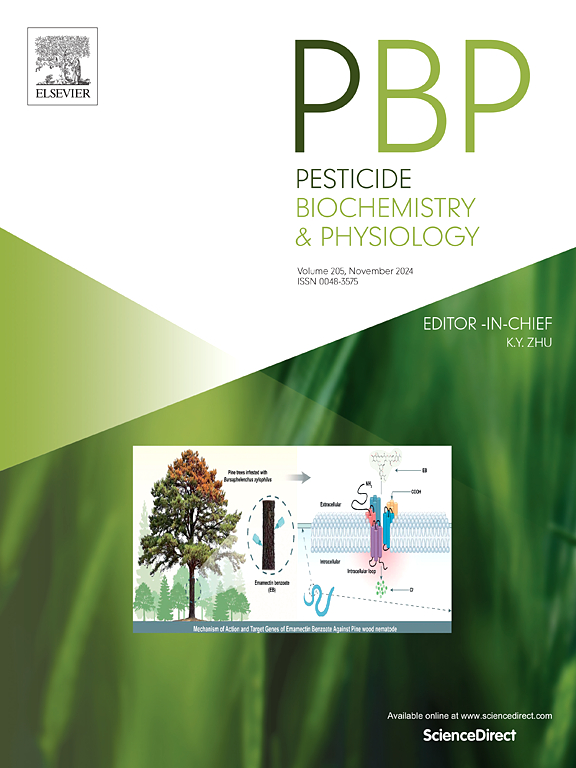Antibacterial mode of action of thyme white (Thymus vulgaris L.) essential oil and its constituents, thymol and carvacrol against Agrobacterium tumefaciens via down-regulation of manganese transport genes, sitABCD and mntH
IF 4
1区 农林科学
Q2 BIOCHEMISTRY & MOLECULAR BIOLOGY
引用次数: 0
Abstract
In this study, we evaluated the antibacterial activities of plant essential oils (EOs) from the Lamiaceae family against Agrobacterium tumefaciens to find new eco-friendly antimicrobials. Thymus vulgaris L. (thyme white) EO demonstrated the most potent fumigant antibacterial activity among these. Key compounds identified in thyme white EO, including thymol, carvacrol, S-(−)-α-pinene, R-(+)-α-pinene, and (−)-limonene, also exhibited strong fumigant antibacterial activity against A. tumefaciens. The inhibition zone diameters observed for thymol, carvacrol, R-(+)-α-pinene, S-(−)-α-pinene, thyme white EO, and S-(−)-limonene were 2.85, 2.74, 1.64, 1.55, 1.15, and 0.86 cm, respectively, at a concentration of 5 mg per paper disc. Only thyme white EO, thymol, and carvacrol exhibited contact antibacterial activity against A. tumefaciens. The minimum inhibition concentrations (MIC) of thyme white EO, thymol, carvacrol, and streptomycin were 800 μg/mL, 350 μg/mL, 350 μg/mL, and 3.125 μg/mL, respectively. Using confocal laser scanning microscopy, we observed intracellular reactive oxygen species (ROS) production and membrane damage in A. tumefaciens treated with thyme white EO, thymol, and carvacrol. Additionally, we analyzed the differential gene expression level in A. tumefaciens treated with thyme white EO, thymol, and carvacrol, comparing them to untreated cells to elucidate the mode of action. In particular, the expression of manganese transport-related genes (sitABCD and mntH) was significantly downregulated, which impaired the function of sod. As a result, the system responsible for detoxifying ROS was disrupted. This led to excessive accumulation of ROS, causing damage to the cell membrane.

百里香白(thyymus vulgaris L.)精油及其成分百里香酚和香芹酚通过下调锰转运基因sitABCD和mntH对农杆菌的抑菌作用模式
在本研究中,我们评价了Lamiaceae家族植物精油(EOs)对农杆菌的抑菌活性,以寻找新的环保型抗菌药物。其中百里香白(thyymus vulgaris L.,百里香白)EO的抑菌活性最强。百里香白EO中鉴定的关键化合物,包括百里香酚、香芹酚、S-(−)-α-蒎烯、R-(+)-α-蒎烯和(−)-柠檬烯,也具有较强的抑菌活性。百里香酚、香芹酚、R-(+)-α-蒎烯、S-(−)-α-蒎烯、百里香白EO和S-(−)-柠檬烯在5 mg /纸片浓度下的抑菌圈直径分别为2.85、2.74、1.64、1.55、1.15和0.86 cm。只有百里香白EO、百里香酚和香芹酚对大肠杆菌具有接触性抗菌活性。百里香白EO、百里香酚、香芹酚和链霉素的最小抑制浓度分别为800 μg/mL、350 μg/mL、350 μg/mL和3.125 μg/mL。利用共聚焦激光扫描显微镜观察了百里香白EO、百里香酚和香芹酚对A. tumefaciens细胞内活性氧(ROS)的产生和膜损伤。此外,我们分析了经百里香白EO、百里香酚和香芹酚处理的A. tumefaciens细胞的差异基因表达水平,并将它们与未处理的细胞进行比较,以阐明作用模式。特别是锰转运相关基因(sitABCD和mntH)的表达显著下调,使sod功能受损。结果,负责解毒ROS的系统被破坏。这导致活性氧的过度积累,对细胞膜造成损伤。
本文章由计算机程序翻译,如有差异,请以英文原文为准。
求助全文
约1分钟内获得全文
求助全文
来源期刊
CiteScore
7.00
自引率
8.50%
发文量
238
审稿时长
4.2 months
期刊介绍:
Pesticide Biochemistry and Physiology publishes original scientific articles pertaining to the mode of action of plant protection agents such as insecticides, fungicides, herbicides, and similar compounds, including nonlethal pest control agents, biosynthesis of pheromones, hormones, and plant resistance agents. Manuscripts may include a biochemical, physiological, or molecular study for an understanding of comparative toxicology or selective toxicity of both target and nontarget organisms. Particular interest will be given to studies on the molecular biology of pest control, toxicology, and pesticide resistance.
Research Areas Emphasized Include the Biochemistry and Physiology of:
• Comparative toxicity
• Mode of action
• Pathophysiology
• Plant growth regulators
• Resistance
• Other effects of pesticides on both parasites and hosts.

 求助内容:
求助内容: 应助结果提醒方式:
应助结果提醒方式:


